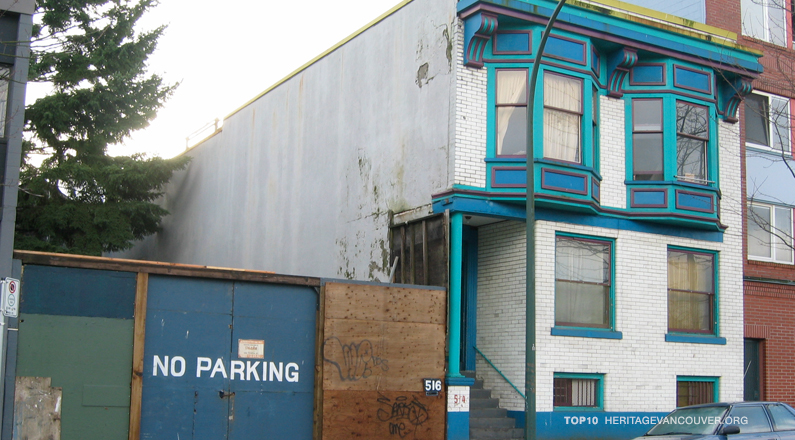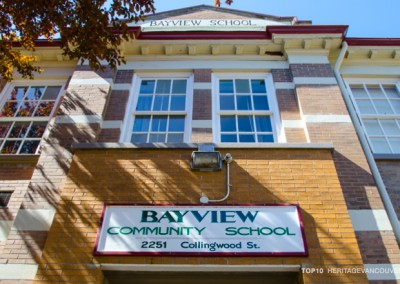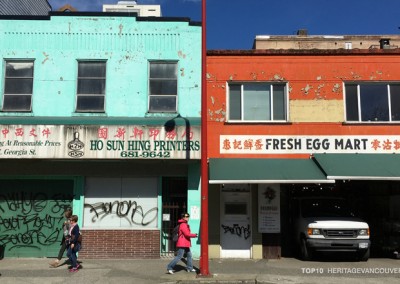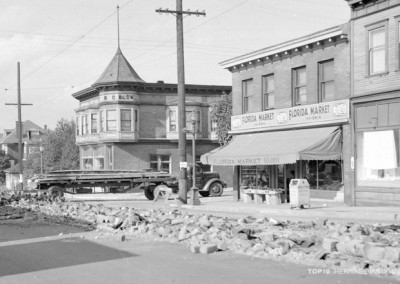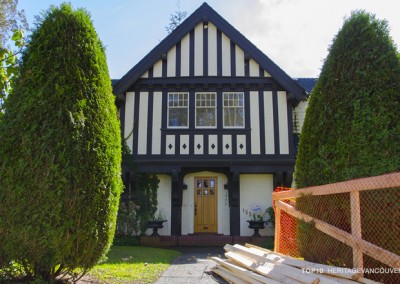Strathcona is the home of some of Vancouver’s oldest buildings, but not many of the sites on the Heritage Register are protected from demolition through heritage designation.
A unique cluster of 1911-12 buildings in the 500 and 600 blocks of Alexander Street, where the Red Light District once thrived, are threatened by potential development pressure.
Of the buildings that remain, and are known to have been brothels, only 500 Alexander Street is protected, but 514, 610, 662 and 666 Alexander Street are not even listed on Heritage Register and could easily disappear. A number of other early brothels in the area – including those run by Maria Gomez and Fay Packer – have been demolished for social housing projects.
This East End neighbourhood has suffered from the absence of co-ordination in community planning. While Strathcona south of Hastings Street has undergone carefully-managed change, north of Hastings Street is prey to redevelopment. Though the “Downtown Eastside Plan” has a policy to consider a Heritage Conservation Area for Japantown, heritage sites throughout the area bounded by Main Street, Hastings, Heatley Avenue, the Port and the CPR tracks are facing the threat of demolition.
Heritage Vancouver supports the recognition of the Red Light District through additions of these sites to the Heritage Register, and zoning and planning improvements for Strathcona including the creation of a Japantown Heritage Conservation Area.
Threat
What is the threat to the Red Light District?
Strathcona is the home of some of Vancouver’s oldest buildings, but few of the sites on the Heritage Register are protected from demolition through heritage designation. A unique cluster of 1911-12 buildings in the 500 and 600 blocks of Alexander Street, where the Red Light District once thrived, are threatened by potential development pressure. Of the buildings that remain and are known to have been brothels only 500 Alexander Street is protected, but 514, 610, 662 and 666 Alexander Street are not even listed on Heritage Register and could easily disappear.
A number of other early brothels in the area – including those run by Maria Gomez and Fay Packer – have been demolished for social housing projects. One of the most significant resources in the block, the 1888 Henderson House at 502 Alexander Street, was recently demolished as part of a social housing development.
One issue for the future of the Red Light District is the heritage-friendly zoning in Strathcona south of Hastings Street that is not available north of Hastings Street. Vancouver’s first zoning bylaw allowed the area between Dunlevy to Clark to be zoned for six-storey industrial buildings. This led to “urban blight” which the City attempted to remove through wholesale demolition of Victorian and Edwardian houses in the neighbourhood and construction of social housing in new towers. When its “urban renewal” efforts failed, the City elected to support the retention of the houses below the alleyway south of Hastings through the new RT-3 Zone. No protective zoning was given for houses or smaller buildings to the north or along Hastings Street.
This East End neighbourhood has suffered from the absence of co-ordination in community planning. While Strathcona south of Hastings Street has undergone carefully-managed change, north of Hastings Street is prey to redevelopment. Though the “Downtown Eastside Plan” has a policy to consider a Heritage Conservation Area for Japantown, heritage sites throughout the area bounded by Main Street, Hastings, Heatley Avenue, the Port and the CPR tracks are facing the threat of demolition.
Significance
Why is the Red Light District significant?
The 500 and 600 blocks of Alexander Street are identified as important for the Red Light District that existed here from 1911 to 1914 in the City of Vancouver’s “Japantown Historical and Cultural Review”. Brothels in “rooming houses” along Alexander Street were seen in this planning study to be reflective of social life and economic conditions in the early history of Strathcona.
Known as “Vancouver’s first neighbourhood”, Strathcona was settled south and east of the earliest major employer, Hastings Mill, at the foot of Dunlevy Avenue, near today’s Railway Street. The Japantown study identifies the past and present value of this area as a “welcoming community” where special needs housing and support services were situated near to the port’s industrial and commercial activity.
Vancouver has a cyclical history of the tolerance and suppression of “carnal vice.” As part of the infant city, the original Red Light District emerged in the 1890s in walking distance of the mill on Dupont (later Powell) Street, but shut down in 1907 after the City raided it. Brothels quickly moved a short distance to Canton Alley and Shanghai Alley, in Chinatown, then onto Shore Street in 1907 (to 1912). The 100-block of Harris Street was renamed Shore Street, which eventually because East Georgia Street and was where the original Harris-Georgia Viaduct started/ended in 1913. After more police crack downs, the madams moved the Red Light District from Shore Street to Alexander Street in 1912.
Brothels were found in apartments and houses located at 500, 514, 610 and 666 Alexander Street and 662 Alexander Street. Remarkable for the era, the owners of three, perhaps four, of the buildings and businesses were women.
The 500 and 600 blocks of Alexander Street also continue to be important for their location on the edges of historic Japantown, in Strathcona. Many hotels, churches, houses, tenements and apartment buildings that remain in the area were built for, or by, Japanese-Canadians or have significant Nikkei history.
Position
Heritage Vancouver’s position
- Heritage Vancouver supports the recognition of the Red Light District through additions to the Heritage Register and planning and zoning in Strathcona that:
- Creates a clear vision for the Strathcona neighbourhood, one that reintroduces integration of Strathcona north and Strathcona south.
- Creates a Japantown Heritage Conservation Area and considers its expansion to protect the area of Strathcona north of Hastings Street.
- Extends RT-3 Zoning to help safeguard historic houses north of Hastings Street in the same way as Strathcona south of Hastings Street.
Actions
What you can do
- Under the Heritage Register Update undertaken as part of the Heritage Action Plan, 514, 610, 662 and 666 Alexander Street – and many others in Japantown – have been identified as significant heritage resources. Write a letter to Mayor and Council to support the addition of significant heritage sites to the City’s Heritage Register.
- Participate in neighbourhood planning within the Strathcona neighbourhood.
- Write a letter to Mayor and Council to act on the recommendations of the Downtown Eastside Plan and create a Heritage Conservation Area for Japantown.
Updates
Resources
500 Alexander Street (1912)
Built in 1912 by the Burrard Construction Company for J. McCarter, designed by architect W. T. Whiteway, and a construction cost of $15,000. Building permit no. 1992.
DL 196; Block 42; Lot 1
514 Alexander Street (formerly 538 Alexander Street) (1912)
Built in 1912 by W. McMullen for Alice Bernard for $14,500. Building permit no. 1534
DL 196; Block 42; Lot 8
608-610-612 Alexander Street (1911)
Built in 1911 by E. Woolridge for N. E. Arnold & L. St. Clair for $35,000, described as a ‘rooming house’.
DL 196; Block 43; Lots 2 & 3
662 Alexander Street (1912)
Built in 1912 by R. V. Pushaw for Mrs. A. C. Alter for $6,300, described as a ‘three-storey brick rooming house’. Building permit no. 1609
In March 1920, an addition was placed in the rear by Dixon & Murray for owner G. Kubota, at $2,000, building permit no. 11401.
DL 196; Block 43; Lot 13
666 Alexander Street (1912)
Built in 1912 by R. V. Pushaw for A. C. Alter for $6,300, described as a ‘three-storey brick rooming house’. Building permit no. 1850 issued March 25, 1912.
In 1921, owner Mrs. A. C. Alter had repairs made worth $50.00, by C. Vaglio. Building permit no. A-2104 issued October 20, 1921.
DL 196; Block 43; Lot 14
